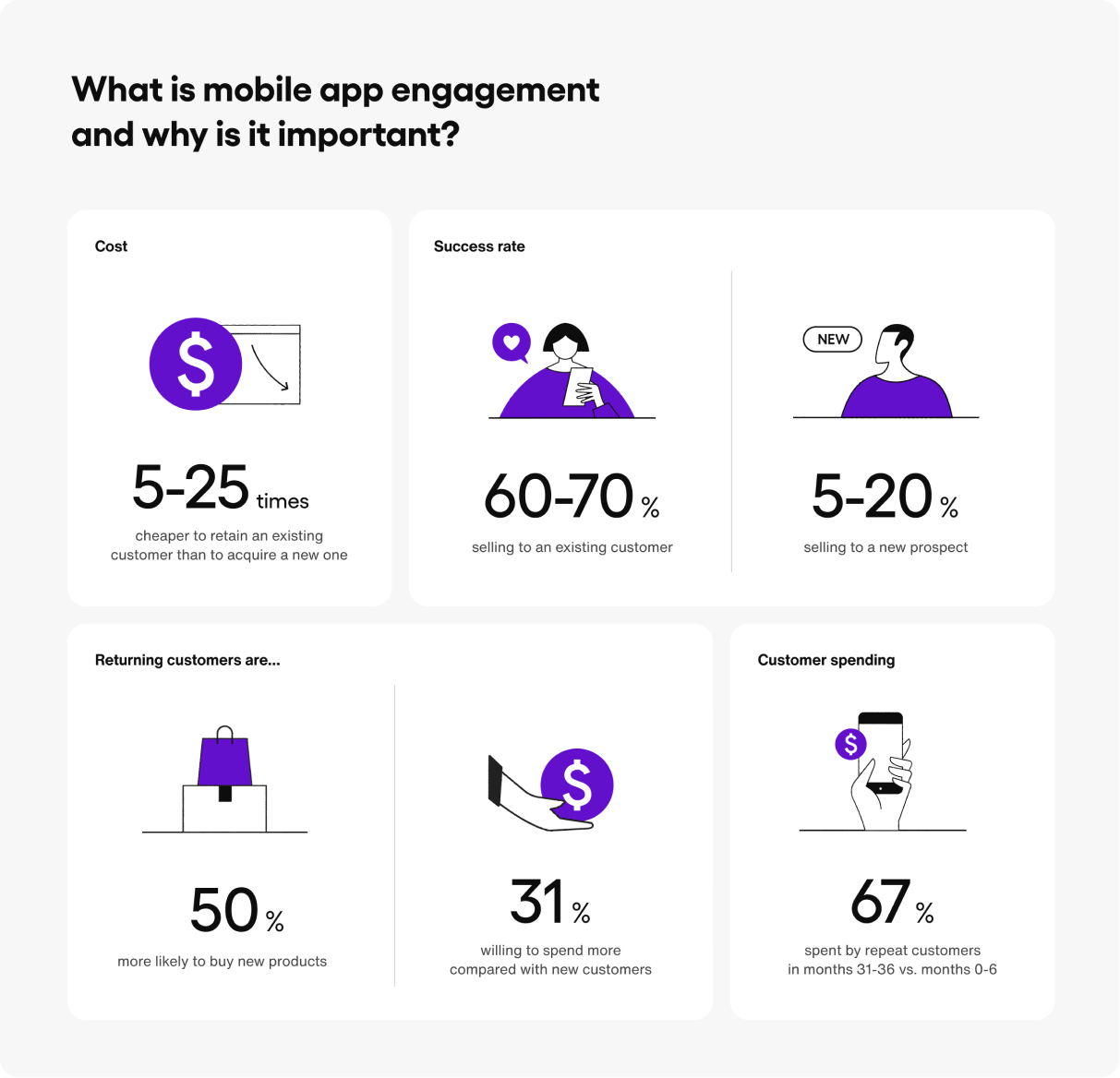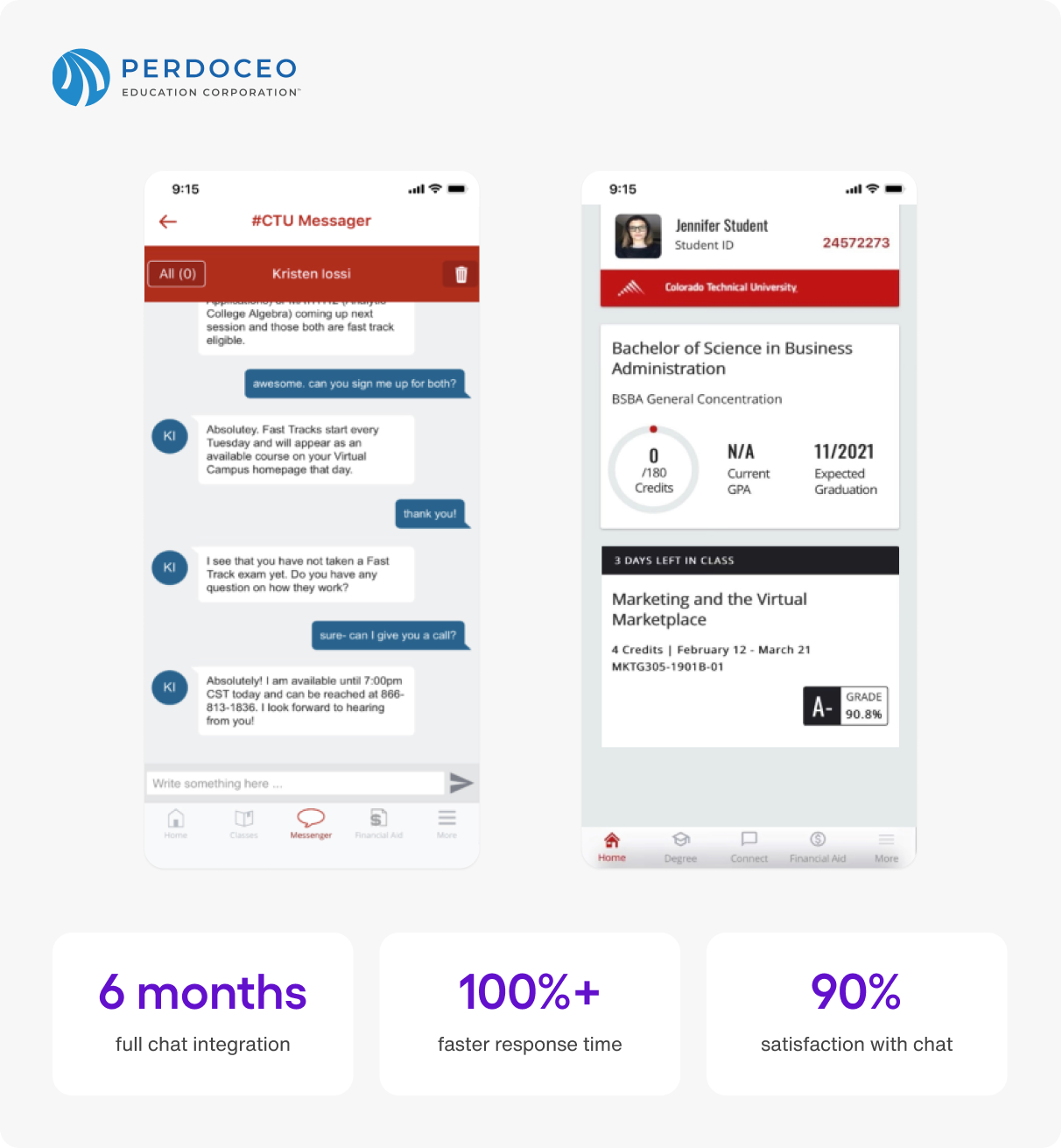Keeping customers in app: The guide to mobile engagement
What is mobile engagement?
Mobile engagement is all about how mobile users interact with an application. The more engaged users are with your application, the more likely they’ll come back and meet your conversion goals – over and over again.
By measuring engagement, you uncover the path for improving both the customer’s experience and your application’s in-market success. And because true mobile engagement increases retention rates, it also reflects the strength of your user base, something critical to your app’s success.
So why are retention rates themselves so important? Whether you monetize your app through subscription, ad sales, or in-app purchases, you need to keep users coming back. Here’s why:
- Returning customers are 50% more likely to buy new products from you and willing to spend 31% more compared with new customers. Adding to this fact, Success rates soar to 60-70% when selling to existing customers, compared with 5-20% when selling to a new prospect.
- It’s 5 to 25 times cheaper to retain an existing customer than to acquire a new one.
- Repeat customers are likely to spend 67% more in months 31-36 of their engagement with your company than months 0-6 (that is, when they were new customers).
If you’re planning to reap the benefits of repeat customers with a long lifetime value, then it’s important to recognize that mobile app engagement is the precursor to customer retention and the key to growing your user base and improving profitability.

High engagement means that users are more likely to return to your app, subscribe to your services, make in-app purchases, leave good reviews on the app store, and tell others about your product. If mobile engagement plays such an important role in business success, how can you properly support it?
Beyond install rates
Many companies celebrate when a critical mass of people begin to download an app, seeing install rates as a key factor in determining success. The challenge of these same companies is keeping those users engaged and using the app.
The average uninstall rate for mobile apps is 28% after 30 days and about 25% of apps are used only once during the first six months. Installations, then, have to be celebrated alongside strategically prioritizing a roadmap to ensure that users stay in-app and happy.
In most companies, business teams like customer experience and sales support have limited influence on the product roadmap. But these teams have a strong understanding of customer and user needs and frustrations.
One result of this business-to-product optimization gap is that companies may fail to prioritize mobile engagement builds that serve the business. For example, conversational messaging and streaming, which could be the very features that make some apps the centerpiece when it comes to a competitive advantage within an industry, can be overlooked. Serving the customer better amongst app competition is key as the number of applications users are downloading grew by 7% between 2020 and 2021 and roughly 5 million applications exist between Itunes and Google Play stores.
By approaching mobile engagement not just as a matter of application development but as an executive-level business strategy, the development roadmap can maximize value on the business front.
Setting your strategy
By now, you may have recognized that mobile app engagement should be part of your app development strategy. But how specifically can you assess whether you are on the right track for connecting and communicating with your customers? What checkpoints exist for you to improve on your existing engagement?
Provide valuable and relevant interactions
Users will only return to your app if they find value through interactions. This means you have to know your audience, create relevant content, and meet their expectations. Value can come in many shapes and forms. People expect current and accurate information from a news app. They may want to analyze their activities and performance over time in a fitness app. Relevant and timely product recommendations are necessary in e-commerce apps.
From the time of developing recommendations or customized feeds, you may begin considering creating a user-to-user function or a community, where your customers can come together and organically create content and groups around the places that brought them into the app in the first place.
Deliver a high-quality mobile experience
No matter how great your content is, app users won’t realize the value if they can’t find what they need and engage with the features. Your User Experience (UX) design is just as important as your content. The UI should be easy to use and intuitive, while the app should load quickly and work well on all platforms and mobile devices.
It is also essential to recognize that customer satisfaction moves beyond the UI. How quickly and how efficiently can a user solve a problem or navigate to what they need, if their query is not part of a common workflow? Companies have solved for this by opening up communication channels and chatbots are seeing higher customer satisfaction.
How to measure success
According to management guru Peter Drucker, “What gets measured gets managed!” If you want to improve your mobile app engagement, you must track the right KPIs to ensure that you’re making meaningful improvements. You can determine mobile engagement by measuring multiple metrics that paint a holistic picture of how users interact with your app.
Metrics for Developers
- Session duration
This metric measures how much time users spend interacting with an app. Keep in mind that longer isn’t necessarily better; the duration should be proportional to the quantity and type of your content. For example, you’d be hard-pressed to find someone who’d stare at the weather app for 20 minutes, even if they absolutely love it!
Session duration can help you spot problems with your content, User Interface (UI), user flow, and more. For example, short sessions can be caused by issues with the UI or navigation. A decreasing session duration could mean that users are losing interest, so you may need to assess the quality of your content or add new features. - Session interval
This metric shows how often users open an app, and the frequency of use depends on the type of app. People may use services such as news and weather forecasts daily. Meanwhile, they may interact with, for example, health apps (e.g., sleep, self-help) for longer sessions but once every few days. Besides the behaviors of individual users, you can also analyze the ratio of one-time users to regular ones to see how you can increase the number of interactions and entice users to come back more often. - Session depth
Opening an app to check for new content requires less effort on the user’s part than making a purchase, joining a loyalty program, or leveling up in a game. An involved user who has more meaningful interactions with an app is more likely to return because they have invested time and energy into the relationship.Session depth measures the number of interactions per session or how far a user progresses along the user journey before closing the app. You can identify the content or functionalities that make your app sticky so you can double down on creating features that your ideal audience will love.
Metrics for Product Management
- Engagement
Depending on your app, target audience, and business objectives, you may also track other mobile engagement KPIs. For example, social shares show when and where users share your content. Meanwhile, tracking the channels that users regularly go to connect with your brand or other users and with what frequency they do this will take engagement measurements to the next level. - Retention
How often do people drop-off from your app? What keeps them coming back to it? By analyzing why people leave your app, and where along the user journey they stop engaging, you unlock the key to identifying issues that may be creating a frustrating experience and causing uninstalls. The goal is to plan for a customer lifetime value far higher than the cost of customer acquisition. - Conversion
Conversion goes beyond the percent of your customers that are making a purchase. Instead, conversion is a way of tracking retention along each stage of the customer journey and often involves brainstorming new ways of optimizing for better performance across the funnel. Product managers should measure the behaviors and attributes that play a role in a path to conversion to make sense of the big picture.
Now you understand which metrics set the baseline for mobile engagement and some key areas to optimize. The question that remains is: How can you improve?
Improving mobile engagement
A core component of mobile engagement is to tighten the sense of direct connection between your customers and each other or your customers and you. Sendbird does this by integrating conversations into apps as the most reliable and engaging form of communicating with customers.
Messaging uniquely allows people not sharing the same physical space to interact in very human ways. It is personal, friendly, approachable, rich in emotion, expressive, is available in real-time or on their own time, lets users know when to engage, and keeps the conversation context alive–creating an ongoing connected state between users that deepens their relationship and allows for ongoing conversation.
Sendbird is an always-on messaging conversations channel between businesses and customers that is available–in app, in the moment, and on their own terms–creating an ongoing dialogue that is personal and drives action enabling businesses to build customer relationships that are ongoing and deepen over time.
Open up channels that users prefer
By no surprise, different users from different demographics have distinct communication preferences, and this matters when it comes time to engage. 75% of Generation Z use smartphones as their preferred device and 37% of them will leave a shopping or brand experience if technology does not meet expectations. Even more, 69% of Gen Zers believe companies should help them achieve their goals and not the other way around. As this generation increases its purchasing power and leads the way for millennial buyers, companies must cater to the needs of a digitally savvy audience to achieve desired levels of retention and growth.
To meet new demands, Perdoceo Ed–a highly ranked online university program–lets students reach out to staff and faculty beyond just email with chat. Perdoceo admin can see how long between student reach out and faculty response time, and remind faculty to respond in a timely manner. They needed two-way messaging with read receipts and asynchronous messaging to help connect students, faculty, and admins through their servicing model. Currently, 90% of Perdoceo’s students are satisfied with chat, with messages being addressed in less than 12 hours and 100% faster than what the average student deems acceptable.

By allowing users to connect asynchronously, but also by phone or bot according to their needs, the chances are they’ll come back into the app more frequently no matter the industry.
Offer a custom branded experience
Today’s consumer is sensitive to apps that send them to new windows, confused and frustrated when waiting on unreliable communication sessions, and they notice when the flow of an application truly caters to them, allowing for the direct connection and seamless experience that they crave. It’s best practice then to avoid pointing in-app users to unfamiliar ecosystems and to ensure that communications and operational tasks are streamlined within a custom, if not fully personalized, UI.
PayTM is India’s leading financial services company with over 21 million merchants onboard and millions of customers completing transactions through the service every day. To better serve these millions of customers and stay competitive, PayTM wanted to move beyond a chronology of transactions and unify the customer experience across a number of product lines and contexts instantiated at scale.

Abhishek Madan, Head of Product at Paytm Insider wanted an identity-first approach to chat, with all conversations happening seamlessly within a single UI and allowing users to click on another’s profile to see conversations and context into transactions. By partnering with Sendbird’s platform API, the company was able to offload a lot of complexity within this build, and 85% of the massive user base was immediately satisfied with the new functionality.
Plan for trust and safety
Trust and Safety are topics that go far beyond risk aversion. They signal to your user that you care and respect their needs. Taking care of users means preventing phishing attacks, filtering offensive content, and authenticating sessions to build trust sets applications apart and develop loyalty. Users should have an instinct for how you communicate so when they receive suspicious or spammy text, they remain confident in your brand and come to rely on you.
Accolade is a leader in the health tech space and provides access to quality primary care, mental health support, and expert medical opinions. Needless to say, absolute reliability and HIPPA compliance was something critical to choosing a chat solution and migrating from an inadequate system.
Sendbird facilitated the entire migration using secure file transfer protocol (SFTP), deployed a dedicated instance for Accolade’s messaging traffic and implemented single sign-on (SSO) with SAML. As partners protecting electronically protected health information, Accolade and Sendbird together signed a Business Associate Agreement (BAA), mutually committing to the stringent security required by HIPAA.
As a result of this migration, Accolade experiences less latency for user messages and webhooks, which allows Accolade to build analytics on messaging events.
Customers and patients expect companies to go above and beyond when it comes to trust and safety and for companies this often means aligning the customer relationship with an airtight and strategic approach to internal data.
Integrations and extensibility
Whether your app is a marketplace or delivery platform looking to enhance user-to-user conversations or you intend to connect directly to your customers to communicate marketing promotions, solve customer service queries, or offer a concierge experience, better service and better conversations come through deeper integrations that serve both company and end user.
Sendbird is built to work with any CRM or contact center solution, automates ticket creation, and allows for an embedded agent chat window, and for this reason, companies like Motive turn to Sendbird. Motive, an integrated fleet management platform with a million drivers and 70,000 customers needed a customizable and robust chat API solution to replace their existing one without any service interruption. At the top of their list of ‘must haves’ were easy integration, rich chat capabilities, clickable links, and no loss of data in their transition. After extensive research, they choose Sendbird which could offer the reliability they need, a seamless transition, in record launch time.
Amongst results, mobile engagement increased since integrating Sendbird’s chat API. Back-office users spend over thirty minutes a day on their platform, with 94% returning to their software daily. But Motive’s choice also represents a commitment to trust and safety and a seamless UI experience integrated with a business growth strategy, Motive is also seeing results in their NPS, a drop in customer service calls, and improvements to cost that stem from better communication and saved time.
Conversations 3.0 for mobile engagement
When you incorporate business-centered engagement features, such as in-app chat for sales concierge and customer service or operational messaging and marketing promotions, during prioritization and planning activities, you commit to cost-effectively putting the customer’s experience front and center. This mode of strategic operation is felt and seen at scale by today’s customers, thereby encouraging increased interaction, long-term and retentive relationships, and brand notoriety.
By building mobile engagement into your executive strategy, you move past the competition, set up a data infrastructure for the future, and plan for an award-winning customer experience, which translates directly into customer longevity.
If you’re ready to take action in the face of waning retention and increased competition, then consider going one step further with Sendbird. Our team has created a Mobile Engagement Scorecard that allows you to assess where you stand as compared to your peers and receive an immediate score. We are also offering a mobile engagement score review session with one of our experts to help you strategize, which is bookable at the end of the survey.






